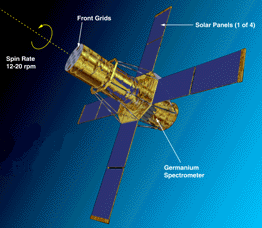|
New UC Berkeley/NASA x-ray spacecraft heads for the sun after Feb.
5 launch
5
Feb 2002
|

Bob
Lin, director of UC Berkeley's Space Sciences Laboratory, and others
applaud as the HESSI spacecraft is launched on Tuesday, Feb. 5, 2002.
HESSI is the first NASA mission in more than a quarter of a century
to be designed, built and operated by a university and its partners.
Pictured left to right are Peter Schroeder, Lin and Andre Csillaghy.
(Photo by Noah Berger)
|
By Diane
Ainsworth, Public Affairs
BERKELEY —
Whoops of
joy and applause erupted in the halls of Berkeley’s Space Sciences
Laboratory multimedia conference room at 12:58 p.m. Pacific time on Feb.
5 as the long-awaited High Energy Solar Spectroscopic Imager (HESSI)
was air-launched from a L-1011 jetliner and blasted into space 40,000
feet over the Atlantic Ocean.
In keeping with the
satellite’s past record of delays, the first launch attempt was
aborted two minutes and seven seconds before HESSI’s scheduled drop
from the belly of the commercial airplane, keeping the science and operations
team in limbo for an additional 30 minutes. Faulty communications prompted
the action. However, after looping around and returning to the launch
location, HESSI was dropped from the jetliner and blasted into orbit
by its Pegasus booster.
"It was fabulous,
my virgin launch," said an elated Beth Burnside, UC Berkeley vice
chancellor of research, who watched the televised launch from the Space
Sciences Laboratory.

Bob
Lin, director of the Space Sciences lab, and vice chancellor Beth Burnside
celebrate following the launch of the HESSI spacecraft on Tuesday,
Feb. 5, 2002. (Photo by Noah Berger)
|
"Terrific,"
said Robert Lin, director of the Spaces Sciences Lab and HESSI’s
principal investigator. "We couldn’t have asked for a better
launch."
Now that it is in
orbit, the satellite comes under UC Berkeley's control, with commands
uplinked and data downlinked through a 36-foot (11 meters) radio dish
at the Space Sciences Laboratory, perched in the wooded hills above UC
Berkeley. From there, HESSI mission operators will monitor the automatic
pointing of the satellite toward the sun, deployment of the four solar
panels, and the spin-up of the satellite to about 15 revolutions per
minute.
The launch came just
six days after another Berkeley/NASA satellite – the Extreme Ultraviolet
Explorer (EUVE) – burned up as it re-entered Earth's atmosphere,
ending an eight-year mission to explore space in the extreme ultraviolet,
a portion of the electromagnetic spectrum never before studied.
Hessi mission
The HESSI mission
will study the high-energy x-ray and gamma-ray eruptions from solar flares,
which follow a 11-year cycle that peaked in mid-2000. However, launch
delays – caused by damage to the spacecraft during testing and subsequent
Pegasus rocket booster failures – kept the spacecraft grounded for
nearly a year and a-half. Despite the setback, solar activity has remained
high this year, and the HESSI science team believes the new solar probe
will be able to image a thousand or more solar flares during its two-year
primary science mission.
HESSI is the first
NASA mission in more than a quarter of a century to be designed, built
as well as operated by a university and its partners. NASA made that
decision as a way to lower the cost of the mission, which is estimated
to be $85 million, said Peter Harvey, HESSI project manager.
Manfred Bester,
HESSI mission operations scientist, designed the lab’s 36-foot-diameter
antenna dish, which will send commands to the four-winged spacecraft
as it passes over Berkeley six times a day.
"What a
perfect flight," he exclaimed as a fax arrived from NASA’s
Kennedy Space Center noting the orbital coordinates of the new spacecraft.
Faster than a
speeding bullet
Once HESSI is
in its final orbit, the spacecraft will be traveling faster than the
speed of a bullet – at 16,900 miles per hour.
 |
| Artist's
concept of HESSI spacecraft in orbit, spinning around an axis pointing
at the sun. Hi-res
version. NASA picture |
HESSI’s x-ray
and gamma ray vision will allow it to take snapshots of solar flares
and "see inside of a solar flare," Lin said. These flares are
seen in visible light as the sudden, rapid and intense brightenings of
the sun's surface near sunspots.
Scientists believe
solar flares release as much energy as several billion megatons of TNT,
but nobody knows how the sun is able to release this much energy or why
up to half of the energy that is released is in the form of high-energy
particles.
Sister satellite,
EUVE, reenters atmosphere
While solar physicists
begin to probe that mystery, a sister satellite (EUVE) that had charted
new discoveries in the extreme ultraviolet concluded its eight-year voyage,
burning up in the atmosphere over central Egypt on Jan. 30.
The EUVE went
offline in the Science and Mission Operations Center nearly a week before
HESSI spread its wings. Shutdown of all EUVE operations freed Berkeley
operations engineers to begin tracking HESSI and preparing for the next
launch later this year, of the Cosmic Hot Interstellar Plasma Spectrometer.
The 7,000-pound
EUVE satellite, built and operated by a consortium that was led by Berkeley,
allowed scientists to observe distant objects in the Milky Way galaxy
that were impossible to see at other wavelengths. During its long lifetime,
the satellite observed more than 1,000 celestial sources inside and outside
of the Milky Way galaxy.
Additional information:
|